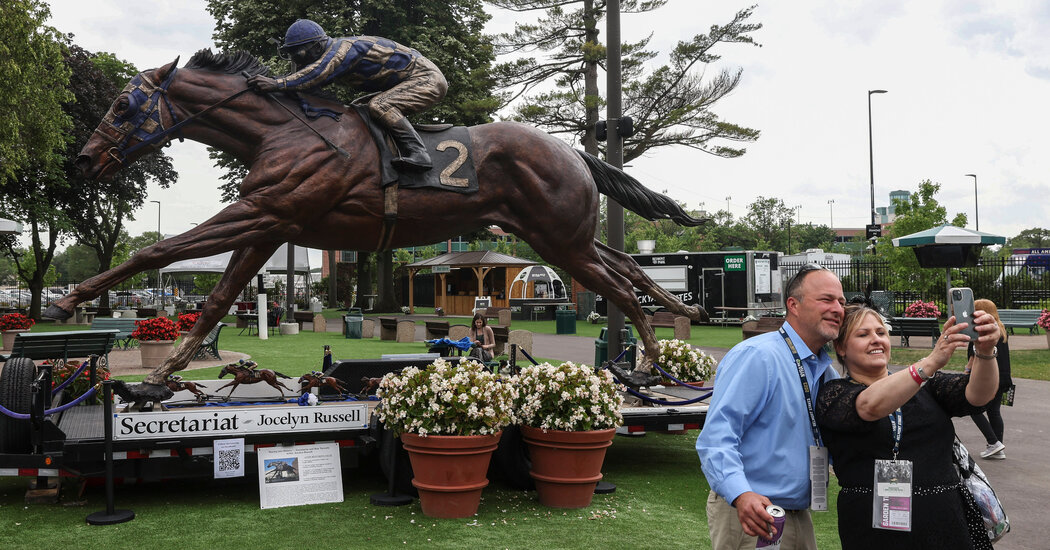Derby Entrant Is Scratched as Four Horse Deaths Renew Safety Concerns
LOUISVILLE, Ky. — Two days before horse racing’s signature event, the Kentucky Derby, Kentucky racing officials on Thursday threw a horse out of the race under a cloud of suspicion after two of his trainer’s horses collapsed and died without explanation in the past week.
Lord Miles, trained by Saffie Joseph Jr., was scratched by state stewards Thursday evening, in a highly unusual move just hours after the trainer declared he would scratch all of his horses entered in races at Churchill Downs except his Derby entrant. Two other horses, not trained by Joseph, also died in the past week after sustaining leg injuries, including a colt who was also scheduled to run in the Derby, prompting an investigation by the Kentucky Horse Racing Commission into the causes of all the deaths.
Joseph’s banishment from the Derby, and from all tracks owned by Churchill Downs Inc., follows a hard line set by the track in 2021 after a colt trained by Bob Baffert, Medina Spirit, failed a drug test after finishing first in the Derby. When the results became known, Medina Spirit was disqualified and Baffert was barred from the Derby and tracks owned by Churchill Downs Inc. for two years.
Horse racing is fighting for its life as animal rights activists call for its end at the same time that waning interest from gambling has put it on the losing side of a battle with sports betting.
“Given the unexplained, sudden deaths, we have reasonable concerns about the condition of his horses and decided to suspend him indefinitely until details are analyzed and understood,” said Bill Mudd, the president and chief operating officer of Churchill Downs Inc. “The safety of our equine and human athletes and integrity of our sport is our highest priority. We feel these measures are our duty and responsibility.”
Wild on Ice, a 3-year-old who had three wins in five career starts and was in the Derby field, was euthanized after he sustained a leg injury while training on the dirt track last Thursday. Take Charge Briana was put down after an injury during a turf race on Tuesday.
The two horses trained by Joseph were Parents Pride, who collapsed on Saturday, and Chasing Artie, who collapsed on Tuesday.
The deaths come during one of the few times each year that the sports world is focused on horse racing: The Derby kicks off the Triple Crown season. The deaths are likely to renew longstanding concerns about the safety of racehorses even as the industry contends with doping scandals, competition from other forms of betting and waning fan interest.
“We have full confidence in our racing surfaces and have been assured by our riders and horsemen that they do as well,” Churchill Downs said in a statement on Wednesday.
At the barn where Lord Miles is stabled, Joseph said on Wednesday that he was “shattered” by the deaths of two of his horses. “The odds of it happening twice is in the trillions,” he said. “I run almost 4,000 horses, and it’s never happened. It doesn’t make sense.”
Lisa Lazarus, chief executive of the newly minted Horseracing Integrity and Safety Authority, said both the dirt and turf courses had been examined by its experts and were deemed to be safe. Necropsies will be performed on the horses, and hair and blood samples have been taken and are being fast-tracked for laboratory examinations. Joseph scratched a filly on Wednesday out of precaution and said on Thursday morning that he would also voluntarily scratch the horses he planned to run Thursday, Friday and Saturday, except for Lord Miles. The commission later decided otherwise.
On Thursday morning, Joseph watched as Lord Miles was walked outside his barn before he was taken to the track for light exercise. Joseph checked the horse’s legs both at the barn and on the track.
Asked afterward if he would scratch Lord Miles, he responded, “No.” Asked why he was checking his legs, he said, “I always do that.”
While Churchill Downs said Wednesday it would “continue to take every measure to ensure that we are providing the safest possible environment for horses on our property,” it did not have the authority to require Joseph to scratch his Derby horse because he was already entered in the race. That decision needed to come from the racing commission.
Joseph, 36, a Barbados native, is a leading trainer based in Florida. His 2022 Derby horse, White Abarrio, finished 16th.
According to a database that tracks medication violations, he was fined $500 for a positive test for clenbuterol, a bronchodilator, at Gulfstream Park in Florida in 2015 and $1,000 for a positive test for aminocaproic acid, which treats bleeding disorders, at Monmouth Park in New Jersey in 2021. He is also appealing a 15-day suspension and $500 fine because of a positive test for gabapentin, an anticonvulsant and nerve pain medication, at Presque Isle Downs in Pennsylvania in 2022. His trainee Artie’s Princess was disqualified from the Grade II race.
Horse racing in the United States has long had a culture of drugs and lax regulation and has a far higher rate of horses breaking down and being euthanized than most other places in the world.
Trainers have experimented with anything that may give their horses an edge, including chemicals that bulk up pigs and cattle before slaughter, cobra venom, Viagra, blood-doping agents, stimulants and cancer drugs. Detection is difficult as laboratories scramble to keep up.
Common drugs such as anti-inflammatories pose the greatest risk to horses and riders. At higher levels, pain medicine can mask injury, rendering prerace examinations less effective. If a horse cannot feel pain, it may run harder than it otherwise would, putting extra stress on an injury.
That was one reason the Horseracing Integrity and Safety Authority was established under the oversight of the Federal Trade Commission. The rules and penalties it has written to eliminate doping and abuse within thoroughbred racing will take effect on May 22.
In 2021, months after Medina Spirit was disqualified from winning the Derby, he died during a workout. A necropsy by California scientists suggested he might have had a heart attack, but they said they could not be sure. They cited an international study of exercise-related sudden deaths in racehorses that found that a cause of death was determined with certainty in about 53 percent of cases, a presumptive cause was established in 25 percent of cases and a specific cause of death could not be determined in about 22 percent of them.
Since 2009, the Jockey Club has kept the Equine Injury Database to track fatal breakdowns on American racetracks and provide a database to analyze how they can be prevented. That first year, thoroughbreds had fatal injuries at the rate of two per 1,000 starts.
Last year, there were 1.25 fatalities per 1,000 starts compared to 1.39 fatalities per 1,000 starts in 2021. It was the fourth consecutive year that the rate had decreased and the first time it had been below 1.3 fatalities per 1,000 starts.
“We can say with confidence that the risk of fatal injury is heading in a sustained downward direction both overall and in many specific areas,” Tim Parkin, a professor of veterinary epidemiology at the University of Bristol in England, said when announcing the most recent results in March. He said the six months at the end of 2022 was the safest six-month period since the database was created.
Still, clusters of fatal accidents have occurred. Last month, Laurel Park in Maryland was closed for three days after a spate of injuries led to five horses being euthanized. Trainers and owners there said the track’s surface was unsafe. Laurel Park’s owner, 1/ST, disputed the claim.
The sport was badly rocked in 2019 after 30 horses died at Santa Anita in a span of six months, news that made national headlines and earned the scrutiny of California lawmakers and animal rights activists.
In response, state and racing officials strengthened regulations regarding the use of riding crops, medications for horses, education for trainers and jockeys, track safety and recuperation policies for injured horses. Last year, 12 horses died at Santa Anita, and thoroughbred fatalities throughout California fell 54 percent from 144 in 2019 to 66 for the last fiscal year.


